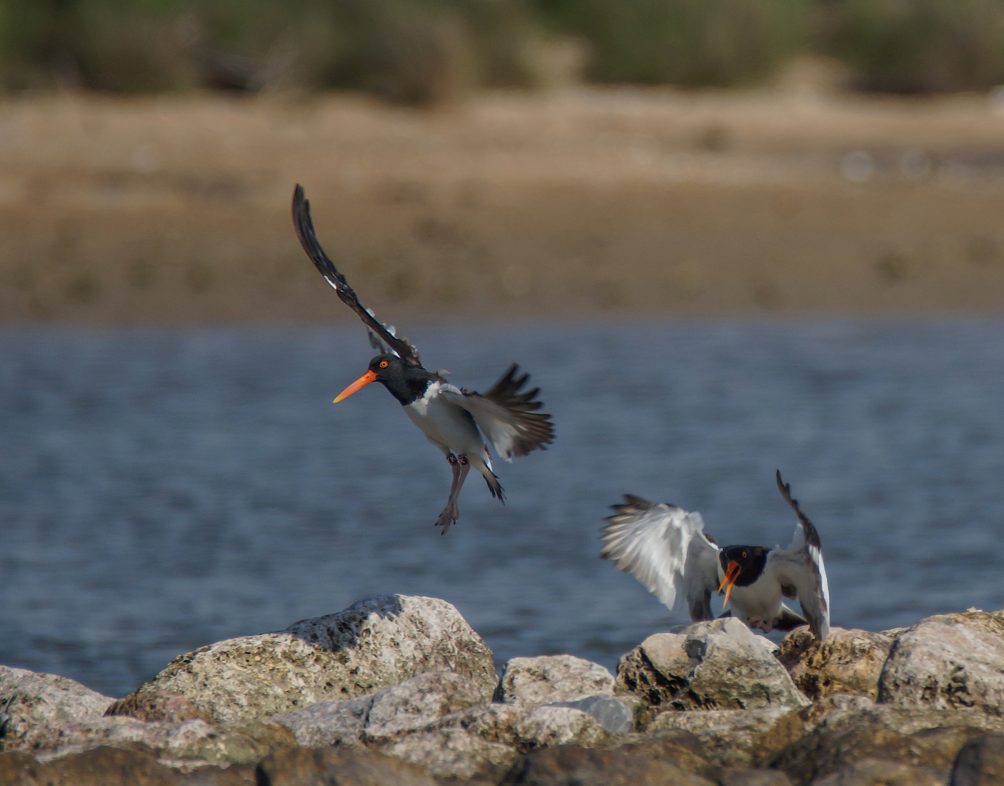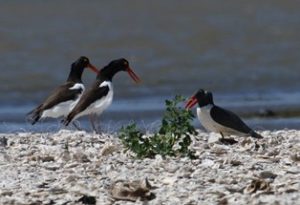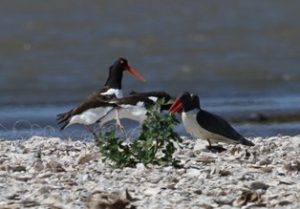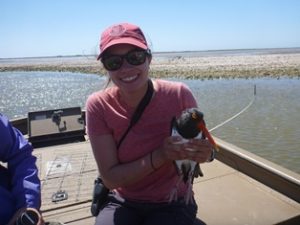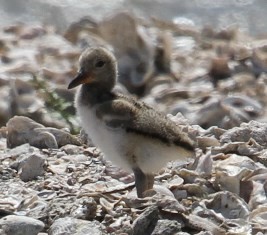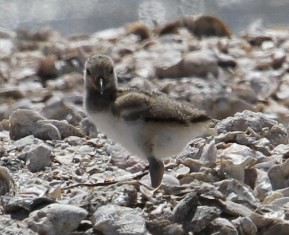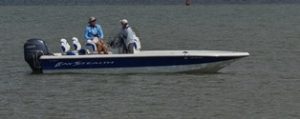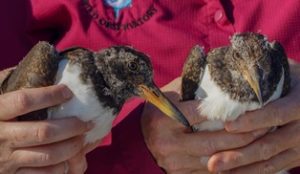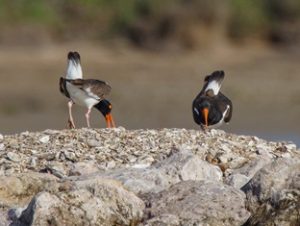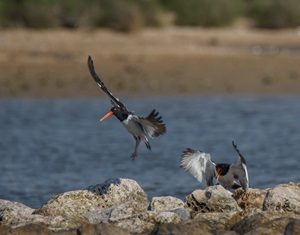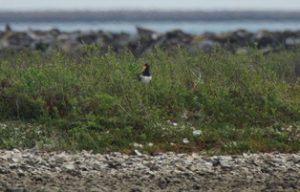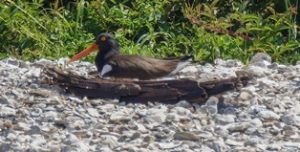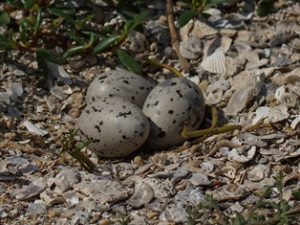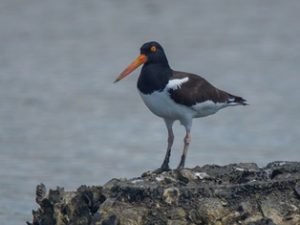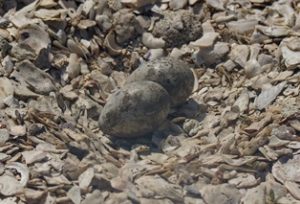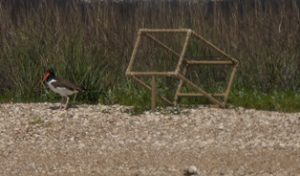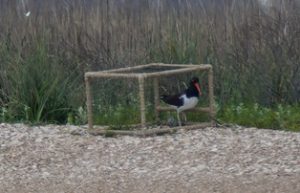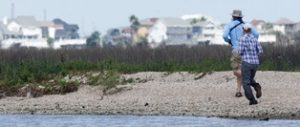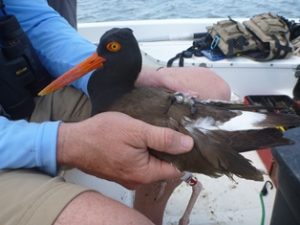By Susan Heath
On Monday, Amanda and I were joined by Allison Huysman who is working at the Mad Island Marsh Preserve banding station this spring. Things have been a little slow so far this year at the banding station and Allison was up for a day on the water so invited her to come along. It’s always exciting to get an oystercatcher in someone’s hands!
If you remember, most of the nests in East Matagorda Bay had failed last week. Sadly, this week none of those pairs had renested but several had some nice scrapes going so I expect some new nests next week. Also last week we saw the Bill Baker, the tug boat that we put a Motus antenna one. Incredibly we saw it again this week!
I wanted to put out a nanotag in East Matagorda Bay so I can monitor it each week and see how it does. Another researcher had trouble with the nanotags we are using not lasting very long on oystercatchers so the manufacturer tried to make ours a little more hardy for these birds with very strong bills. Because of that I wanted to put a tag out where I can check it each week to see if it’s still working. We set up the noose carpets on an unbanded pair at the Oyster Farm which is on the Gulf side of the bay. The birds came in right away and started doing their thing.
We had to wait about 15 minutes but then the male got caught and Amanda ran to get him. I don’t know if you can see in this photo, but he has one leg caught in a noose.
We banded him with the KT bands and I put the nanotag on him. He was pretty happy to be done with us. Here’s Allison holding him just before release.
Then we headed over to Old Gulf Cut to check on the chicks. I had a moment of panic when we saw the adults and didn’t see the chicks but then Amanda spotted one and with a little searching with the binoculars, I spotted the other one laying down on the shell near the first one.
It’s looking right at us. I wonder what its thinking?
On Wednesday we headed out to West Galveston Bay with Tim Long and Alan Wilde. The weather was gorgeous and the wind was just enough to keep us cool but not cause us grief. Excellent! But the tide was super low and Tim had a heck of a time keeping the boat from getting grounded. Thank you Tim!
We headed over to Struve Luci first thing because K6 & JA’s chicks needed to be banded and I planned to put a nanotag on one. We checked out all four pairs and found L8 & L9 still incubating their nest, 12 & unbanded out feeding on a reef, and HM & unbanded walking around with two tiny chicks. Yes their nest hatched!
There is an art to catching oystercatcher chicks. You have to approach from a direction that gives them lots of room to run. Otherwise, they will jump into the water and once that happens there’s no catching them. They can swim and dive quite proficiently. So we planned our attack and run they did. Their other defense is to lay down and blend in with the substrate. They are really good at that too so you have to keep your eye on them. One laid down pretty quickly and I got that one. Amanda had to chase the other one a bit farther but eventually it laid down too. Phew. Chasing down chicks is always nerve wracking.
We took them back to the boat and banded the bigger one (it is now U4X) and then Amanda and I got the transmitter on. It wasn’t too hard and the chick was calm through the whole thing. It looked pretty good when we were done. Amanda held it to let the glue dry while I banded the other chick (it is now U0Y). We’ve run out of two character codes for the chicks so we’ve had to start using the three character ones. I only have a few two character codes left for adults and then I’ll have to start using the three character ones for them as well.
When we let the chicks go, they toddled off to mom and dad none the worse for the wear. The goal of the transmitters is to learn where the chicks go once they leave parental care so hopefully the transmitter will keep transmitting that long. The batteries should last at least 6 months. I’ll be checking every week with handheld receiver to make sure it’s still working until the chick goes off on its own. That’s when we’ll learn some really neat stuff!
After that we made the rounds like we always do. We checked on the pair that are defending the shell pad on the breakwater. YK was standing on top guarding it when we arrived. While we were watching another bird showed up. They engaged in a little cocked tail display trying to decide who was in charge.
Eventually, YK explained in no uncertain terms that the intruder was not welcome.
K7 & unbanded’s nest had hatched too but they were keeping their chicks well hidden in the vegetation so we didn’t see them.
Good thing too because there are a lot of Laughing Gulls there. Keep those babies safe! We found that WW & unbanded had a new nest on Jigsaw. As far as I know this is the first time that WW has had a nest. He is K6 & JA’s chick from 2013 and was banded in the exact same place as the chicks we banded today.
We started noticing a trend as we made our way around the bay. There were a lot of birds in this posture.
Nests! They were everywhere. We found ten in all. I guess the oystercatchers got the memo that it’s time to lay eggs.
The tide was so low that the oystercatchers were getting all muddy.
And a bunch of the eggs were covered in mud.
We set up the box trap on a nest on South Deer.
And we caught the bird!
And then this happened.
Tim and Amanda ran to get the bird out of the box. We banded him KK and I put a nanotag on him.
I can’t wait to start getting some of this data back to see how they roam around when they aren’t breeding. It took a while to document all those nests so we didn’t get back to Tim’s house until almost 4:00. A long but rewarding day.
We’ve had a great response to the Adopt-an-Oystercatcher program! Thank you to everyone who has adopted a pair of birds. I will be sending out updates at the end of every month and sometimes in between if something exciting happens with the pair you adopted. If you aren’t familiar with the program – you can adopt a pair of oystercatchers for a $100 donation and I will update you monthly on their progress throughout the breeding season.
Current Stats for upper Texas coast from Dickinson Bay to East Matagorda Bay: 15 nests being incubated, 5 failed nests, 4 nests with unfledged chicks, 0 nest with undetermined status, 0 chicks fledged
This project is supported by the National Fish and Wildlife Foundation and several private donors. If you would like to contribute you can do so by clicking on the Donate Now button below. All donations are tax deductible and GREATLY appreciated.

